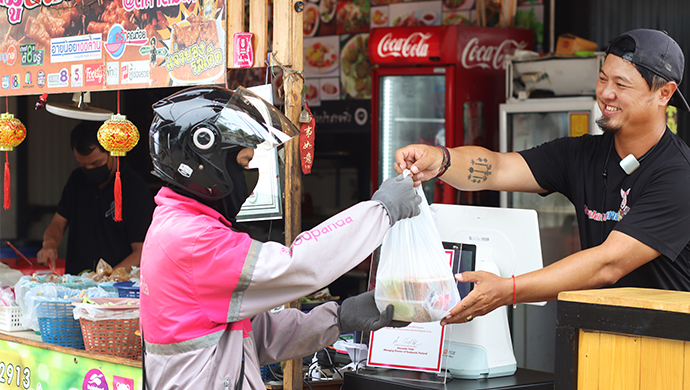
Over the past decade, the online food delivery space has been growing steadily in Asia owing to ever-increasing smartphone penetration and ease of ordering food using mobile apps. This trend has been expedited in the past two years with online food delivery becoming an essential service amidst movement restrictions due to the pandemic.
Globally, the online food delivery market is worth more than US$35 billion annually and is forecasted to reach US$365 billion by 2030. A Google-Temasek report forecasts that the food delivery market in Southeast Asia alone is expected to grow from US$2 billion in 2018 to an estimated US$8 billion in 2025. With a drastic shift in consumer behaviour towards online food delivery platforms amidst the pandemic and given increasing demand, there is a pressing need to fill this gap.
As such, global, regional, as well as local players are making strides across different markets in the region. The largest player in the online food and grocery delivery landscape in Asia is foodpanda which operates in more than 400 cities across 12 markets. Regionally, the foodpanda platform reaches more than 10 million people in Asia, building an ecosystem connecting riders, merchant-partners, and everyday customers using the platform.
foodpanda: Capturing appetites in Asia
Jakob Angele, CEO of foodpanda who comes with a background in management strategy, has been spearheading foodpanda’s expansion and growth across the region for more than six years. “When I first joined foodpanda, it was a small, independent company that looked very different. There was not much excitement among investors about food delivery platforms; we had to start with very little funding and faced many challenges. Since those early days, many things have changed and business has grown extremely fast, even before the pandemic” said Jakob.
Back in 2012 when foodpanda was first launched in Singapore with just 51 restaurants, and a focus on the CBD area, the online food delivery scene in Asia was quite young. foodpanda began its venture in the region with operations in five markets, including Singapore, the Philippines, Thailand, Indonesia, and Malaysia. This year, foodpanda commemorates its ninth year of operations in Asia.
At a time when there were no other food delivery aggregator services, foodpanda quickly established itself as the pioneer and go-to online food delivery platform. However, convincing partners was not an easy feat. “We would knock on doors and get rejected multiple times. Interestingly, in Singapore, the first brand that agreed to try us out was Burger King and then other brands started becoming curious. There was no secret recipe though — we had to be very consistent in our efforts and eventually, things turned around,” shared Jakob.

Jakob Angele, CEO, foodpanda
As a pioneer in this industry, Jakob shared that the biggest switch in the business model came around in 2015 when foodpanda was growing quite well. “At that time some restaurants had their riders and that was an easy model for us that was working well for everyone. But eventually, we identified two big problems: the restaurants weren’t able to keep pace with our scale of growth in that we were getting too many orders and restaurants just did not have enough riders, and the second issue was that the subsequent customer experience was getting affected. There was a long wait time, around 60 minutes!” That’s when foodpanda decided to get riders to solve both problems. “This was a stepping stone that helped us scale — we went from 60 minutes to delivering orders within 25 minutes or in 10-15 minutes in some markets through pandamart. We have come a long way,” he added.
In 2016, foodpanda was acquired by Germany-based Delivery Hero, a global leader in the food delivery industry. Today, the online food delivery platform operates in more than 400 cities across 12 markets in the Asia Pacific, including Singapore, Hong Kong, Thailand, Malaysia, Pakistan, Taiwan, Philippines, Bangladesh, Laos, Cambodia, Myanmar, and Japan. For foodpanda, a major part of Delivery Hero’s Asia business saw significant growth in the region with orders increasing by 194% as compared to 2019 and GMV growing more than double. In the first half of 2021, the food delivery platform completed more than 747 million orders — almost three times the number of orders from just one year ago.
Since then, foodpanda has been aggressively expanding in the region over the past five years. From 2019 to 2020, foodpanda started operations in Myanmar, Cambodia, and Laos. In September last year, the company launched operations in Japan, its 12th market in the region, hoping to grow a “still largely untapped” market and further strengthen its position as the leading food delivery player in the region.
Navigating the challenges of food delivery in diverse Asia
Asia is an extremely diverse market with a wide range of demographics, and there is no one-size-fits-all business model or market condition for the region. Jakob explained that one of the main challenges in Asia is that significant groundwork is necessary. This includes educating consumers on what food delivery means and how it can make their lives easy; From a marketing point of view, creating educational videos, and tapping into local channels of social media have become an integral part of their core business strategy. foodpanda operates not just in developed and urban markets like Singapore and Hong Kong but also in developing markets, such as Bangladesh and Pakistan where user demographics are completely different.
Also read: Making construction cleaner, greener, and more climate-friendly
Jakob shared that localisation has become extremely important and relevant in a region like Asia. “Internal organisation and strategic decision-making are key to success in Asia. We have empowered local operations in terms of commercial and operational strategy, from how to run logistics, picking cities, identifying restaurants, to how we spend our money,” he said.
As the regional CEO, while Jakob is involved in those decisions, the country teams play a vital role. “We understand that no matter how smart the headquarters are, even if I travel to each country three times a month, a local understanding comes only if you live there,” he added. “One of the main reasons behind foodpanda’s success in a diverse region like Asia is the fact that a lot of tech and operational innovations are created by our local teams that understand the nuances of their markets. This is very unique to foodpanda,” he said.
Adapting to the new normal: quick commerce
Amidst the pandemic, like most businesses, foodpanda was also faced with multiple challenges. Many countries went into lockdown, and many restaurants couldn’t open. “COVID-19 was hectic. The world around us changed as we knew it, but the team did an amazing job to respond and react to this,” said Jakob. The foodpanda team worked closely with their restaurant partners to come up with the best way to cope. Suddenly, they were also faced with a huge influx of restaurants reaching out to be onboarded as partners needed to digitalise.
“Previously, we had around 14 days to help restaurants go live, but during COVID-19, they needed to go live the next day. We had to reinvent our whole onboarding process to be more responsive. For restaurants in financial trouble, we tried to support them by allowing them to defer their payments in some cases,” shared Jakob. To ensure safety for the riders and consumers while providing accessibility, variety, and convenience, the food delivery platform was also the first to launch contactless deliveries as a default option.
Also read: How businesses can maximise their growth using the right financial tools
They have also added the delivery of groceries and daily essentials to their service repertoire. foodpanda is spearheading the growth of quick-commerce (q-commerce), where groceries and daily essentials are delivered on-demand, within 25 minutes. Across the region, foodpanda partners tens of thousands of retail and SME partners as part of its foodpanda shops vertical, including supermarkets like Tesco, convenience stores like 7-Eleven and Family Mart, plus health and beauty stores like Watsons and Guardian. This is in addition to the thousands of SMEs, mom-and-pop stores, and neighbourhood bakeries or speciality foods on the platform.
In 2019, foodpanda launched its first pandamart cloud stores in Singapore and Taiwan, offering customers a wide selection of over 5,000 groceries and daily essentials at the touch of a button. foodpanda today operates Asia’s largest network of cloud grocery stores, with more than 200 pandamarts across 40 cities in 10 markets — a number that foodpanda is looking to double within the year as it expands its grocery delivery offerings.
What’s next?
foodpanda’s main focus is to use even smarter technology to power q-commerce. Be it food or groceries, they want to deliver anything customers need in 25 minutes to their doorstep. With COVID-19, consumer behaviour has evolved and appetites for safety and convenience have grown exponentially. Previously hesitant consumers are also going online for daily needs. This is why the q-commerce model works, and it will become even more integral to everyday lives.
“There is now a higher level of interest in our offerings. There were many new downloads, including different demographics like older customers aged 55 and above who are now using our technology. We see these customers using us even after the pandemic, and this gives us a lot of confidence that we are on the right track,” shared Jakob. However, he added that COVID-19 has been a challenging time in that they’ve had to adapt to highly localised government rules and regulations that are dynamic and sometimes very complex. So, a critical focus is how to continue helping riders and merchants sustain their businesses and earnings during the crisis and beyond.
The food delivery sector in Asia may be competitive, but platforms like foodpanda have proven to offer restaurants and F&B establishments, SMEs, and even delivery riders a valuable lifeline in the midst of the pandemic. Businesses that contribute to uplifting communities and promoting digital inclusion and empowerment will play a key role in the overall economic recovery of the region.
– –
This article is produced by the e27 team, sponsored by foodpanda
We can share your story at e27, too. Engage the Southeast Asian tech ecosystem by bringing your story to the world. Visit us at e27.co/advertise to get started.
The post foodpanda: Taking Asia’s food delivery ecosystem through the pandemic and beyond appeared first on e27.

